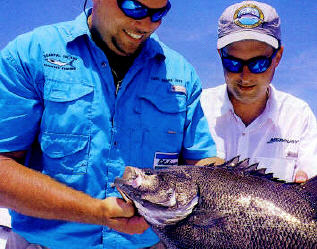May 16, 2011
By Chris Dummit
What do Port Canaveral, Flamingo and Jekyll Island, Georgia, have in common? Loads of spring tripletail.
By Chris Dummit

This specimen stood out on a sunny, calm day. Fly casters statewide consider tripletail a premier sight-casting fish.
|
No one knows why tripletail flock to Port Canaveral March through May, and to Jekyll Island, Georgia, from April through June. These fish are found all along the southeast Atlantic coast and in the Gulf, but they're usually scattered, and almost always associated with structure.
The only thing the two sites have in common is a single geographic element: They both feature a shallow bight-a watery cul de sac that indents the coastline. Still, in the cove near Canaveral, the fish are orienting around buoys and on weedlines and submerged aeronautical rip-rap from shuttles and rockets. The Jekyll fish, on the other hand, are just there.
In both areas, fly fishermen are discovering the thrill of sight casting to these oddly endearing fish.
In the case of Jekyll Island, maybe tripletail orient along eddy currents, suggests Capt. Richie Lott, who guides out of nearby St. Simons Island. Or perhaps it's the bait: loads of pogies and shrimp. Some anglers theorize these shallow waters just north of the Florida-Georgia border are used as a spring spawning site, though tripletail spawn many times from spring through summer. Whatever the reason, each year tripletail by the thousands gang up over the sandy, mostly featureless bottom off the beaches of Jekyll Island. Anglers come, too, from all over southeast Georgia and northeast Florida to tackle the trips.
"Tripletail are batch spawners. In the northern Gulf, the season is May through August," said Jim Franks, a fisheries biologist at the University of Southern Mississippi who has started tagging tripletail in the Gulf and also off Canaveral with the help of Capt. Troy Perez. "We know they grow extremely fast-five pounds in one year. Males mature in their first year; females in their second year."
Very little information has come from the few recaptures of tagged Canaveral tripletail. It appears that most are recaptured in the same area. However, one tagged fish made its way up near Jekyll. It's the only known connection between the two locations, which lie about 240 miles apart.
Capt. Troy Perez is not only the primary angler tagging tripletail around Canaveral, he and wife Christine hold several flyrod and many conventional International Game Fish Association world records for the species. Christine Perez currently holds the women's records on 8- and 12-pound tippet with a 6-pound fish in each category. Troy owns the 8-pound line-class record with a 26-pounder.
While Canaveral and Jekyll Island have definitely been the hotspots in recent years, fly fishermen who take the time to look elsewhere have been finding other fishable concentrations of trips.
Records are also coming out of the Flamingo area of Florida Bay, where there are rumors of smaller tripletail concentrations holding around old submerged bomb craters in the backcountry.
Rusty Albury, an Islamorada guide who holds the 8-pound tippet record with a 14-pound, 12-ounce tripletail, says he started noticing several years ago that tripletail were showing up with tarpon in May from Flamingo west. The fish hold either just below the surface or float near bank points where the water drops from about two feet to 10 feet, around channel markers and edges, and in potholes at the edges of banks.
"We start seeing them in May and June, and it seems like in July or August, they tend to team up. We see more than one fish together at a time," Albury said. "In August and September, we see a lot of males with chunks taken out of their sides like they're fighting."
Canaveral's spring run begins in March when the water temperature reaches 68 degrees.
Forty-fish days are common in the spring, Troy Perez said. In summer and fall, the fish linger but the numbers dwindle. Still some of the biggest tripletail-in the 30-pound range-are caught in October.
Tripletail resemble an oversize crappie or bream. And while they appear docile as they lie on the surface waiting to ambush prey, they are hardy fighters that frequently jump when hooked. Florida regulations allow anglers to keep two fish a day that measure 15 inches or more; Georgia law allows five fish per day with an 18-inch minimum size limit.
